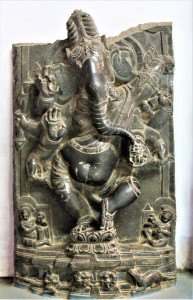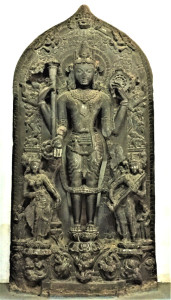Registered with the Registrar of Newspapers for India under R.N.I 53640/91
Vol. XXVIII No. 9, August 16-31, 2018
Our Museum’s wealth
by Chithra Madhavan
Pala Art – such intricacy, such detail
In front of a small bay on the first floor of the main section of the Madras Museum hangs a board with ‘Medieval Sculpture-Pala Sena’ written on it. It is unfortunate that very few visitors to the museum notice it. Those who do, and those who pay close attention to the few sculptures of the Pala-Sena dynasties that are here, are richly rewarded. These artifacts belong to an era which was known for an efflorescence of artistic activity. The mighty Pala Emperors ruled over most of the present-day states of Bihar and West Bengal, and also Bangladesh for nearly four hundred years from the 8th to the 12th Centuries C.E.. and, for the most part, were contemporaries of the Cholas of South India. They were succeeded by the Senas.

Dancing Ganesha
An image of Ganesha of black stone, from Rajashahi in Bangaladesh, is in this section of the Museum. Its damaged condition does not take anything away from the skill of the anonymous sculptor who carved it. The beautiful sculpture of this deity (Nritta Ganapati) is in a dance pose with the left leg slightly bent and resting on a lotus. Ganesha has three bends in the body (tri-bhanga), and has eight hands which is a rarity. In the uppermost right hand Ganapati holds a garland of beads (japa mala), with just one finger. Another hand holds the axe (parasu), the third, unfortunately damaged, is in the gesture of assuring devotees not to fear (abhaya hasta) and the fourth right hand is seen hanging reaching down to the waist and holding an object which is not clearly seen.
The topmost left hand is stretched upward; the second holds the elephant-goad (ankusha), the third holds an object which is not clearly seen but could be the pasha (elephant-goad) and the fourth holds a bowl of modaka. Two tiny sculptures of Siva’s attendants, one playing the cymbals and another the drums, are seen on either side. On one side of the base of the pedestal is Ganesha’s mouse (mushika) and on the other side is a supplicant devotee.

Vishnu (Pala Era).
There are two sculptures of Vishnu from Kanaipara in Mushirabad District, West Bengal, and another from Bihar. It is known that Hinduism, Vaishnavism in particular, was very popular in the Pala region, especially in the areas of present day West Bengal and Bangladesh.
One sculpture from Kanaipara is slightly damaged, but is a beautiful piece of art. Though carved with a back slab, the image seems almost removed from it. A keen observer will note that the weapons Vishnu carries in this sculpture are not in their usual places. The mace (gada) is held in the upper right hand where there is usually the discus (chakra); the chakra is held in the upper left hand where there usually is the conch (sankha) and the lower right hand is in varada-hasta (boon-conferring pose) with perhaps the lotus embedded in the palm. Unfortunately, the lower left hand which would once have held the sankha, is broken near the elbow. Flying celestials are seen at the top of the back slab while two attendant deities, one with a fly-whisk and another with a musical instrument flank this deity. The other sculpture of Vishnu from the same place is similar but less damaged. The carving of Vishnu from Bihar is almost like the ones from West Bengal, but since the hands are not damaged, the lower right hand with the lotus in it and also the conch in the lower left hand can be clearly seen.
In the Pala-Sena collection are also to be seen sculptures of Brahma, Surya and Uma- Maheshwara. The one of Uma-Maheshwara is eye-catching as such a carving is seldom seen in the temples of Tamil Nadu. Parvati is seated on Siva’s right lap and the pedestal on which they sit has Nandi carved beneath Siva and a lion sculpture beneath Parvati. A Siva gana merrily dances near Nandi with his outstretched left hand touching the foot of Siva.
The sculpture of Surya, standing straight and holding lotuses in both hands, conforms to all the iconographical details for this deity given in the scriptures. Seven horses are carved on the pedestal beneath, symbolically representing the chariot on which the Sun God travels upon. One can imagine how beautiful this carving would have looked before it was damaged. Brahma with an intricately carved halo and with the vehicle (vahana) Hamsa on the pedestal is another Pala masterpiece in this museum.
Buddhism was a thriving religion in the Pala times, especially in Bihar and numerous sculptures of various deities of this religion have survived till today. The Madras Museum’s collection in the Pala-Sena section includes a sculpture of Tara, one of the most important deities in Buddhism. Standing absolutely straight, again with a back slab, and with two attendant deities, this image exudes serenity.
Incidentally, one of the most important connections between the medieval Tamil country and the Bengal area was the expedition sent by Rajendra Chola I in the 11th Century C.E.. His army defeated the Pala king and the waters of River Ganga were triumphantly brought to the Chola capital. Along with the sacred Ganga water also came many a Pala sculpture – in bronze and in stone – many of which can be seen in Tamil Nadu today, some even in worship.
Such intricacy, such detail! It is such a pity most visitors to the museum don’t stop and pay attention to these exhibits and a greater pity that our school textbooks say so little about this dynasty and its contribution to the art of India.


Great article, thanks !! It is mentioned that the Chola armies brought back many Pala sculptures which are in TN today being worshipped. Is there any list of these sculptures, where they are, provenance etc?